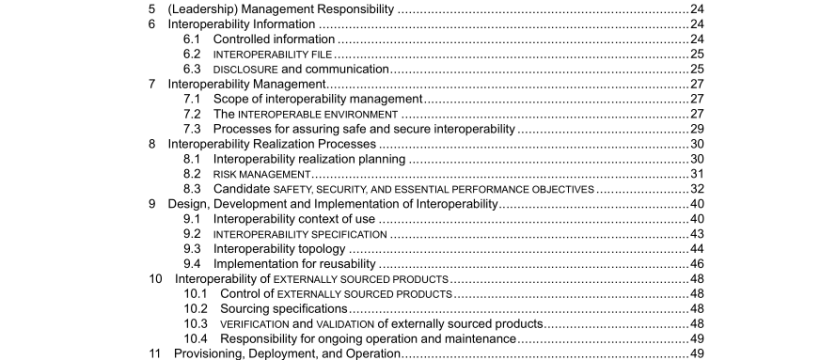UL 2800-1-2019 pdf download.Medical Device Interoperability.
2 Scope 2.1 This Standard is applicable to INTEROPERABLE MEDICAL PRODUCTS , including assembled systems of INTEROPERABLE MEDICAL PRODUCTS that comprise or are intended to be incorporated into INTEROPERABLE MEDICAL SYSTEMS within an INTEROPERABLE ENVIRONMENT . 2.2 This Standard specifies a baseline set of requirements for assuring safe and secure interoperability for INTEROPERABLE MEDICAL SYSTEMS . 3 References 3.1 Any undated reference to a code or standard appearing in the requirements of this Standard shall be interpreted as referring to the latest edition of that code or standard. 3.2 The following standards are referenced in this Standard: AAMI Standards AAMI TIR57, Technical Information Report: Principles forMedical Device security– RiskManagement ASTM Standards ASTM F2761, Standard for Medical Devices and Medical Systems – Essential safety requirements for equipment comprising the patient-centric integrated clinical environment (ICE) – Part 1: General requirements and conceptual model IEC Standards IEC 60601-1, Standard for Medical Electrical Equipment – Part 1: General Requirements for Basic Safety and Essential Performance IEC 60601-1-8, Standard for Medical Electrical Equipment – Part 1-8: General Requirements for Basic Safety and Essential Performance – Collateral Standard: General Requirements, Tests and Guidance for Alarm Systems in Medical ElectricalEquipment and Medical Electrical Systems IEC 62304, Standard forMedical Device Software – Software Life Cycle Processes
4 Terms and Definitions 4.1 ACTOR – An active or passive entity, human or non-human, capable of initiating action or providing data, potentially in response to commands. NOTE 1: An INTEROPERABLE ITEM is a special case of non-human ACTOR. NOTE 2: Health IT systems including Electronic Medical Record systems or Physician Order Entry systems are examples of non- human ACTORS that may not be INTEROPERABLE ITEMS. NOTE 3: Medical devices are examples of non-human actors (which may or may not comply with the requirements of this Standard, i.e., may or not be INTEROPERABLE ITEMS). NOTE 4: OPERATORS and PATIENTS are examples of human ACTORS. NOTE 5: ACTORS may be distinguished by context of use including DEVELOPMENT CONTEXT OF USE ACTORS (e. g., interoperable medical system manufacturers), DEPLOYMENT CONTEXT OF USE ACTORS (e.g., clinicians, bio-medical engineers, etc.) 4.2 ALARM CONDITION – State of the ALARM SYSTEM when it has determined that a potential or actual HAZARDOUS SITUATION exists for which OPERATOR awareness or response is required. NOTE 1: An ALARM CONDITION can be invalid, i.e. a false positive ALARM CONDITION. NOTE 2: An ALARM CONDITION can be missed, i.e. a false negative ALARM CONDITION. ©IEC. This material is reproduced from IEC 60601-1:2006+A1:2012 with permission of the American National Standards Institute (ANSI) on behalf of the International Electrotechnical Commission. All rights reserved. 4.3 ALARM LIMIT – Threshold used by an ALARM SYSTEM to determine an ALARM CONDITION . 4.4 ALARM SETTINGS – ALARM SYSTEM configuration, including but not limited to: a) ALARM LIMITS ; b) The characteristics of any ALARM SIGNAL inactivation states; and c) The values of variables or parameters that determine the function of the ALARM SYSTEM . NOTE: Some algorithmically-determined ALARM SETTINGS can require time to be determined or re-determined.
4.7 ALARM SYSTEM – Parts of ME EQUIPMENT or a ME SYSTEM that detect ALARM CONDITIONS and, as appropriate, generate ALARM SIGNALS . ©IEC. This material is reproduced from IEC 60601-1-8:2006+A1:2012 with permission of the American National Standards Institute (ANSI) on behalf of the International Electrotechnical Commission. All rights reserved. 4.8 ALARM SUPPRESSION – Action taken by the ALARM SYSTEM to not generate an ALARM SIGNAL at the OPERATOR’S position when an ALARM CONDITION is detected. 4.9 ARCHITECTURE VIEW – Artifact within the INTEROPERABILITY ARCHITECTURE expressing the architecture from the perspective of specific set of concerns. Adapted by UL from ISO/IEC/IEEE 42010-2011 with permission of the American National Standards Institute (ANSI) on behalf of the International Organization for Standardization. All rights reserved. 4.10 ARCHITECTURE VIEWPOINT – Constraints establishing the conventions for the construction, interpretation, and use of an ARCHITECTURE VIEW to frame a specific set of concerns. Adapted by UL from ISO/IEC/IEEE 42010-2011 with permission of the American National Standards Institute (ANSI) on behalf of the International Organization for Standardization. All rights reserved. 4.11 ASSURANCE – Grounds for justified confidence that a claim has been or will be achieved. NOTE: Assurance activities include verification and VALIDATION activities that provide OBJECTIVE EVIDENCE for claims reflected in INTEROPERABLE ITEM SSEPOs and INTEROPERABILITY SPECIFICATION.UL 2800-1-2019 pdf download.
UL 2800-1-2019 pdf download
